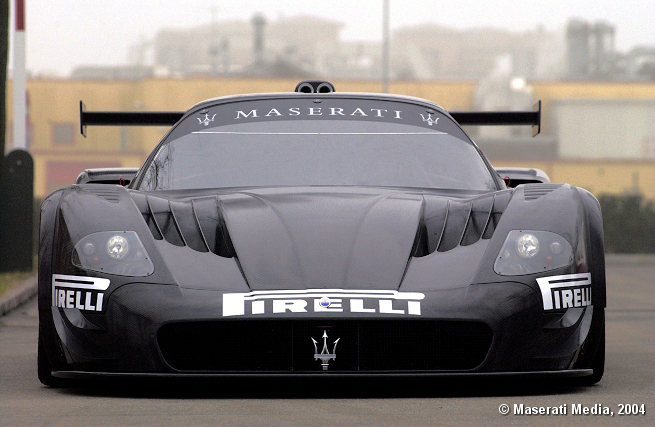


Yesterday at Fiorano saw the track debut of the Maserati that will take part in
the FIA GT championships. The car, which at the moment goes by the
codename of the MCC project, will be unveiled at the forthcoming Geneva Motor
Show, along with the Trident marque?s latest road-going Granturismo car
(MCS) on which it is closely based.
The two versions were produced as the result of a synergy between the Maserati
engineers and those from the Modena company?s race department, under the
technical direction of engineer Giorgio Ascanelli.
The race debut is scheduled for the second half of the 2004 FIA GT
Championship, prior to taking part in the whole series the following year. The
Maserati team will line up two cars as an official presence, as permitted in the
current regulations, while others will be run in the hands of private teams. The
MCC meets all the preparation requirements for homologation in the GT Supercar
category and its development will be entrusted to Andrea Bertolini, the sports test
driver for the Ferrari-Maserati Group.
The car has a carbon chassis, with a total weight of 1100 kg and features
interesting aerodynamics. It features welded steel push-rod suspension and is
fitted with Pirelli PZero tyres.
The engine is a 65 degree V12 with a capacity of 5998 cc, coupled to a manual six
speed sequential gearbox. This type of layout has been a trademark of Maserati?s
racing history. In fact, in 1956, it produced its first 12 cylinder (a 60 degree V,)
which made its Formula 1 debut the following year, fitted to the final version of the
250F. The engine, known as the Tipo 2 (2491 cc,) was an example of the very
latest technology at the time. Ten years after it was built, this engine was still
competitive, through various evolutions, all with a three litre capacity. In 1961, the
Tipo 58 was fitted to the Birdcage Tipo 63, which competed in the Le Mans 24
Hours. The Tipo 9 and the Tipo 10 were both used in Cooper chassis respectively
winning the 1966 Mexican Grand Prix with John Surtees and the 1967 South
African Grand Prix with Pedro Rodriguez. Only the 1493 cc Tipo 8, which was
developed in 1961, did not get past the experimental stage.
The MCS/MCC project came together in a very short space of time, with
preliminary work beginning in May 2002. In September that year the road going
car?s styling buck was ready, while work on computer design was underway in
January 2003, taking two months to complete. Last September saw two MCS
prototypes take shape. One of them began road testing in November, while the
other passed the crash tests in December. Halfway through 2004, 25 cars will
have been built to meet the minimum requirement for racing homologation. The
first competition car however was already underway in November 2003 and
currently, the Maserati Racing Department is working on the build of the second
MCC chassis.
It's rumored that the street version (MCS) will outperform the Enzo both in benchmark tests and on the track. I guess we'll just have to wait for a head-to-head showdown between the two.